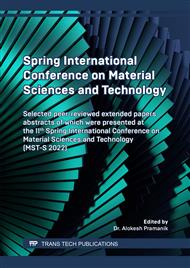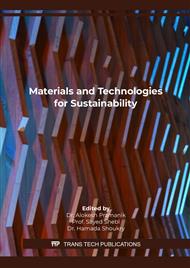[1]
Y. Liu, P. Han, A.M.A. Bazzi, A comparison of rotor bar material of squirrel-cage induction machines for efficiency enhancement purposes, EPE'15 ECCE-Europe, pp.1-7.
DOI: 10.1109/epe.2015.7311778
Google Scholar
[2]
T. Shi, F. Zhao, H. Hao, Z. Liu, Costs, Benefits and Range: Application of Lightweight Technology in Electric Vehicles, SAE Technical Paper 2019-01-0724, (2019).
DOI: 10.4271/2019-01-0724
Google Scholar
[3]
R.W. Cahn, P. Haasen, E.J. Kramer, Material science and technology, vol 8/9. Wiley, New York, (2005).
Google Scholar
[4]
J.A. Garcı́a-Hinojosa, C.R. Gonzalez, G.M. Gonzalez, Y. Houbaert, Structure and properties of Al–7Si–Ni and Al–7Si–Cu cast alloys nonmodified and modified with Sr, J. Mater. Process. Technol. 143 (2003) 306-310.
DOI: 10.1016/s0924-0136(03)00479-5
Google Scholar
[5]
G. Rajaram, S. Kumaran, T.S. Rao, Effect of graphite and transition elements (Cu, Ni) on high temperature tensile behaviour of Al–Si Alloys, Mater. Chem. Phys.128 (2011) 62-69.
DOI: 10.1016/j.matchemphys.2011.02.069
Google Scholar
[6]
Z. Asghar, G. Requena, H.P. Degischer, P. Cloetens, Three-dimensional study of Ni aluminides in an AlSi12 alloy by means of light optical and synchrotron microtomography, Acta Mater. 57 (2009) 4125-4132.
DOI: 10.1016/j.actamat.2009.05.010
Google Scholar
[7]
Z. Asghar, G. Requena, F. Kubel, The role of Ni and Fe aluminides on the elevated temperature strength of an AlSi12 alloy, Mater. Sci. Eng. 527 (2010) 5691-5698.
DOI: 10.1016/j.msea.2010.05.033
Google Scholar
[8]
J.E. Gruzleski, B.M. Closset, The treatment of liquid aluminum-silicon alloys. Amer Foundry Society, California, (1990).
Google Scholar
[9]
A.K. Dahle, K. Nogita, S.D. McDonald, J.W. Zindel, L.M. Hogan, Eutectic nucleation and growth in hypoeutectic Al-Si alloys at different strontium levels, Metall Mater Trans A Phys Metall Mater Sci. 32 (2001) 949-960.
DOI: 10.1007/s11661-001-0352-y
Google Scholar
[10]
Y.H. Cho, H.C. Lee, K.H. Oh, A.K. Dahle, Effect of strontium and phosphorus on eutectic Al-Si nucleation and formation of β-Al 5 FeSi in hypoeutectic Al-Si foundry alloys. Metall Mater Trans A Phys Metall Mater Sci. 39 (2008) 2435-2448.
DOI: 10.1007/s11661-008-9580-8
Google Scholar
[11]
A.K. Dahle, K. Nogita, S.D. McDonald, C. Dinnis, L. Lu, Eutectic modification and microstructure development in Al–Si Alloys. Mater. Sci. Eng, 413 (2005) 243-248.
DOI: 10.1016/j.msea.2005.09.055
Google Scholar
[12]
M.H. Mulazimoglu, R.A.L. Drew, J.E. Gruzleski, The effect of strontium on the electrical resistivity and conductivity of aluminum-silicon alloys. Metall Mater Trans A, 18 (1991) 941-947.
DOI: 10.1007/bf02668542
Google Scholar
[13]
S.Z. Lu, A. Hellawell, The mechanism of silicon modification in aluminum-silicon alloys: impurity induced twinning. Metall Mater Trans A. 18 (1987) 1721-1733.
DOI: 10.1007/bf02646204
Google Scholar
[14]
Y. Li, Y. Yang, Y. Wu, L Wang, X, Liu, Quantitative comparison of three Ni-containing phases to the elevated-temperature properties of Al–Si piston alloys. Mater. Sci. Eng 527 (2010) 7132-7137.
DOI: 10.1016/j.msea.2010.07.073
Google Scholar
[15]
J. Campbell, Complete casting handbook: metal casting processes, metallurgy, techniques and design. Butterworth-Heinemann, London, (2015).
Google Scholar
[16]
J. Campbell, M. Tiryakioğlu, Review of effect of P and Sr on modification and porosity development in Al–Si alloys. Mater. Sci. Technol, 26 (2010) 262-268.
DOI: 10.1179/174328409x425227
Google Scholar
[17]
J. Zhou, L. Ren, X. Geng, L. Fang, H. Hu, As-cast magnesium AM60-based hybrid nanocomposite containing alumina fibres and nanoparticles: Microstructure and tensile behavior, Mater. Sci. Eng. A, 740 (2019) 305-314.
DOI: 10.1016/j.msea.2017.10.070
Google Scholar
[18]
A. Russell, L.L. Kok, Structure-property relations in nonferrous metals. John Wiley & Sons, Canada (2005).
Google Scholar
[19]
O.A. Kaibyshev Superplasticity of alloys, intermetallides and ceramics. Springer Science & Business Media, Basingstoke, (2012).
Google Scholar
[20]
F.C. Campbell, Elements of metallurgy and engineering alloys. ASM International, Ohio, (2008).
Google Scholar
[21]
B. Larson, Toughness, NDT Education Resource Center, Iowa, (2001).
Google Scholar
[22]
M.H. Mulazimoglu, R.A.L. Drew, J.E. Gruzleski, The electrical conductivity of cast Al− Si alloys in the range 2 to 12.6 wt pct silicon. Metall. Trans A, 20 (1989) 383-389.
DOI: 10.1007/bf02653917
Google Scholar
[23]
S.S. Shin, M.Y. Kim, G.Y. Yeom, The Effect of Sr Addition and Holding Time on Mechanical Property and Electrical Conductivity of Al-10.5% Si-2% Cu Secondary Die-casting Alloys. J. Korea foundry soc, 30 (2010) 205-209.
Google Scholar



